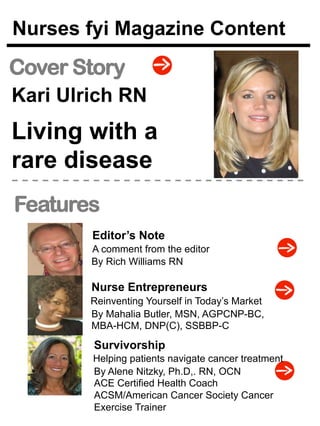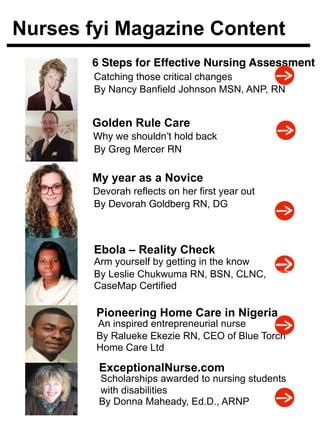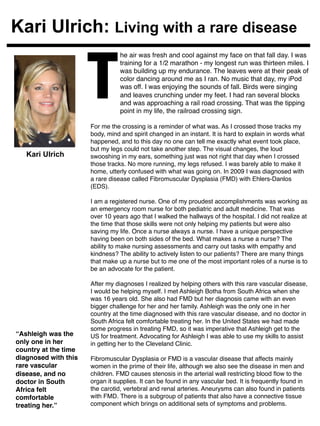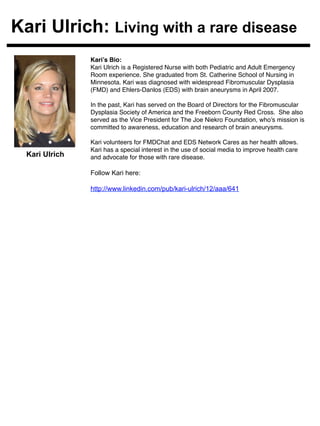KariPDF
- 1. NURSES fyi MAGAZINE ŌĆō NOVEMBER 2014 Issue 19 Golden ! Rule ! Care! Living with a rare disease Pioneering home care in Nigeria Cover Story: Kari Ulrich Ebola- Reality My year Check as a Novice
- 2. Nurses fyi Magazine Content Cover Story Kari Ulrich RN Living with a rare disease Features EditorŌĆÖs Note A comment from the editor By Rich Williams RN Nurse Entrepreneurs By Mahalia Butler, MSN, AGPCNP-BC, MBA-HCM, DNP(C), SSBBP-C Survivorship By Alene Nitzky, Ph.D,. RN, OCN ACE Certified Health Coach ACSM/American Cancer Society Cancer Exercise Trainer Reinventing Yourself in TodayŌĆÖs Market Helping patients navigate cancer treatment
- 3. Nurses fyi Magazine Content 6 Steps for Effective Nursing Assessment! Catching those critical changes! By Nancy Banfield Johnson MSN, ANP, RN Golden Rule Care Why we shouldnŌĆÖt hold back By Greg Mercer RN! My year as a Novice Devorah reflects on her first year out By Devorah Goldberg RN, DG ! Ebola ŌĆō Reality Check Arm yourself by getting in the know By Leslie Chukwuma RN, BSN, CLNC, CaseMap Certified Pioneering Home Care in Nigeria An inspired entrepreneurial nurse By Ralueke Ekezie RN, CEO of Blue Torch Home Care Ltd ExceptionalNurse.com Scholarships awarded to nursing students with disabilities By Donna Maheady, Ed.D., ARNP
- 4. Kari Ulrich: Living with a rare disease he air was fresh and cool against my face on that fall day. I was training for a 1/2 marathon - my longest run was thirteen miles. I was building up my endurance. The leaves were at their peak of color dancing around me as I ran. No music that day, my iPod was off. I was enjoying the sounds of fall. Birds were singing and leaves crunching under my feet. I had ran several blocks and was approaching a rail road crossing. That was the tipping point in my life, the railroad crossing sign. ! T For me the crossing is a reminder of what was. As I crossed those tracks my body, mind and spirit changed in an instant. It is hard to explain in words what happened, and to this day no one can tell me exactly what event took place, but my legs could not take another step. The visual changes, the loud swooshing in my ears, something just was not right that day when I crossed those tracks. No more running, my legs refused. I was barely able to make it home, utterly confused with what was going on. In 2009 I was diagnosed with a rare disease called Fibromuscular Dysplasia (FMD) with Ehlers-Danlos (EDS).! ! I am a registered nurse. One of my proudest accomplishments was working as an emergency room nurse for both pediatric and adult medicine. That was over 10 years ago that I walked the hallways of the hospital. I did not realize at the time that those skills were not only helping my patients but were also saving my life. Once a nurse always a nurse. I have a unique perspective having been on both sides of the bed. What makes a nurse a nurse? The ability to make nursing assessments and carry out tasks with empathy and kindness? The ability to actively listen to our patients? There are many things that make up a nurse but to me one of the most important roles of a nurse is to be an advocate for the patient.! ! After my diagnoses I realized by helping others with this rare vascular disease, I would be helping myself. I met Ashleigh Botha from South Africa when she was 16 years old. She also had FMD but her diagnosis came with an even bigger challenge for her and her family. Ashleigh was the only one in her country at the time diagnosed with this rare vascular disease, and no doctor in South Africa felt comfortable treating her. In the United States we had made some progress in treating FMD, so it was imperative that Ashleigh get to the US for treatment. Advocating for Ashleigh I was able to use my skills to assist in getting her to the Cleveland Clinic.! ! Fibromuscular Dysplasia or FMD is a vascular disease that affects mainly women in the prime of their life, although we also see the disease in men and children. FMD causes stenosis in the arterial wall restricting blood flow to the organ it supplies. It can be found in any vascular bed. It is frequently found in the carotid, vertebral and renal arteries. Aneurysms can also found in patients with FMD. There is a subgroup of patients that also have a connective tissue component which brings on additional sets of symptoms and problems. ! ! Kari Ulrich ŌĆ£Ashleigh was the only one in her country at the time diagnosed with this rare vascular disease, and no doctor in South Africa felt comfortable treating her.ŌĆØ!
- 5. Kari Ulrich: Living with a rare disease Little is known about FMD, which can lead to a delay in diagnosis for many patients. The voices of patients and a few dedicated doctors are paving the way for the future treatment in this disease. Research funding is difficult for rare disease.! ! Rare disease research and drug development is greater than having a pill to swallow for your disease. Rare Disease is a global problem. There are over 7,000 rare diseases with more being discovered everyday. It is estimated that 350 million people worldwide suffer from rare diseases. ! ! In September of 2013, an important NIH study for my rare disease research was stopped. No sufficient reason was given. A decade of data was felt to be significant for a longitudinal study that had the potential to truly characterize a poorly understood disease, whose true cost is really astronomical compared to the relatively small cost of the study. ! ! How does this impact a patient with rare disease? I can speak from my experience as a patient with both Fibromuscular Dysplasia and Ehlers-Danlos - two rare diseases that have overlapping symptoms and therefor overlapping treatments. What works for one disease can impact many diseases.! ! As a case in point, in September 2013 The National Institute of Health (NIH) has halted the only national study on rare connective tissue disease including Fibromuscular Dysplasia, Ehlers-Danlos, Marfans, Aneurysms and Sticklers. This longitudinal study was collecting natural history of rare connective tissue diseases, and included tissue collection. Unfortunately the longitudinal portion of the study was halted. These diseases result in severe disability and even death for those afflicted. This study gave something that is not measurable by numbers. It brought patients together who felt alone in their struggle to get answers to many questions. Patient Advocacy groups were formed, patients talked to each and learned from one another. ! ! Opening communication between these diseases, we are able to bring the research community together to help see the bigger picture of our disease. Patients share what works and what dose not. Rare disease research communities help patients to navigate the health care system to find the best doctors to treat your symptoms. Notice I say treat your symptoms. As many rare disease patients are well aware, a cure is a goal we may not see in our lifetime. But it gives us hope that the next generation will have a cure, or at least learn from our experiences. Rare disease research is much more than the final result. It is a path less taken by many researchers, Pharma, and our government agencies, let alone global collaboration. ! ! Making patients equal partners in the process of rare disease research will lead to better outcomes. Although it can be difficult to define the return on investment for rare disease research as a whole, it can be beneficial with the proper policies in place. ! ! Kari Ulrich ŌĆ£In September of 2013, an important NIH study for my rare disease research was stopped. No sufficient reason was given.ŌĆØ!
- 6. Kari Ulrich: Living with a rare disease The Orphan drug act of 1983 is one of the policyŌĆÖs that can tip the scales to the side of benefiting rare disease. Federal law changes to reduce the cost of orphan drug development and provide incentives to development encourages researchers to investigate rare disease. It is going to take acts of government, Pharma stakeholders, and patients working together globally to establish a best clinical practice. Through research we learn the accurate epidemiology and cause of our disease. Research will lead to better outcomes, faster diagnosis and ultimately better treatment. ! ! Delayed diagnosis and treatment in rare disease has become critical in health care cost and management. According to the Genetic Alliance: Rare Disease Impact Report: It takes approximately 6-7 years for a patient with a rare disease to receive a proper diagnosis. After receiving the proper diagnosis we have the anguish of not knowing what information to trust. Patients become the experts in their disease out of the sheer need to survive. We read, study and learn everything we can about our disease. We weigh our options and are forced to make uninformed decisions because of lack of research.! ! It is difficult for physicians to diagnose and treat diseases without quality research. Patients are demanding quality care no matter what their ailment might be. ! ! Collaboration of Rare Disease Research encompasses more than research and development. It provides a sense of belonging and acceptance through a community. It provides validation to symptoms patients have lived with intimately their whole lives. And most important it gives control back to the patient. We face daily challenges to maintain a status quo quality of life. Patients want to be part of the solution, we were given a problem in life to solve. Rare disease research encompass so much more than finding a cure, it is a path of empathy, caring and healing on a road less travelled.! ! A well funded disease allows patients to make decisions based on statistics and treatment options. With the ability to make informed decisions, better outcomes are achieved. With rare disease there are very little statistics, if any, and treatment options are not scientifically based. Patients are left with a wait and see what happens approach. We have to fight for our research. We get exhausted going through the loop holes. We use all measures possible to get answers, and our efforts at times seem futile as we come across so many road blocks. We cannot do this alone. Rare disease patients expectations are achievable and our lives are worthy. ! ! So again, what impact did closing my rare disease research have? The closure of our research has set back a decade of progress. The scientific and patient community are left with many questions unanswered. How will we spark further investigation when our government gives us conflicting messages? First they were willing to financially invest 10 years of natural history and in the blink of an eye they turn around and state the return on investment was not enough. ! ! Kari Ulrich ŌĆ£Patients become the experts in their disease out of the sheer need to survive. We read, study and learn everything we can about our disease.ŌĆØ!
- 7. Kari Ulrich: Living with a rare disease Rare disease patients need a voice in research. As for our rare connective tissue disease research, patients chose to come together, and we collected over 11,000 signatures asking for reinstatement of our research and researcher. Dr. Francis Collins the Director of NIH is now aware of our disease and is communicating with us to find a solution. We have learned the importance of advocating and making our voices heard. We have learned about how to help in our role of rare disease research by involving our government. We have made a stand in the rare disease community that loss of rare disease research at any juncture is a tragedy for many. There is a chain of life in the rare disease research community. Remove part of the chain at any point and valuable time and resources are lost, and lives are affected. ! ! ! ! Kari Ulrich Please check out Kari in a sample of her YouTube videos! Video Placeholder Video Placeholder
- 8. Kari Ulrich: Living with a rare disease KariŌĆÖs Bio:! Kari Ulrich is a Registered Nurse with both Pediatric and Adult Emergency Room experience. She graduated from St. Catherine School of Nursing in Minnesota. Kari was diagnosed with widespread Fibromuscular Dysplasia (FMD) and Ehlers-Danlos (EDS) with brain aneurysms in April 2007. ! ! In the past, Kari has served on the Board of Directors for the Fibromuscular Dysplasia Society of America and the Freeborn County Red Cross. She also served as the Vice President for The Joe Niekro Foundation, whoŌĆÖs mission is committed to awareness, education and research of brain aneurysms. ! ! Kari volunteers for FMDChat and EDS Network Cares as her health allows. Kari has a special interest in the use of social media to improve health care and advocate for those with rare disease.! Follow Kari here: http://www.linkedin.com/pub/kari-ulrich/12/aaa/641 ! Kari Ulrich








